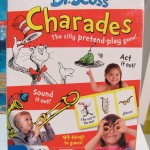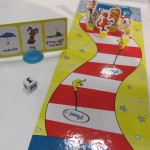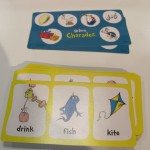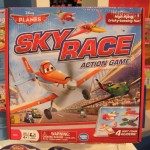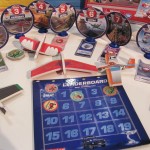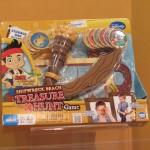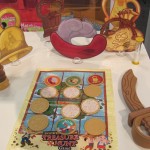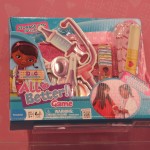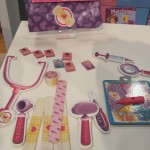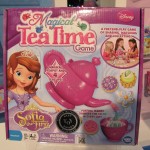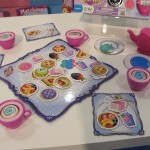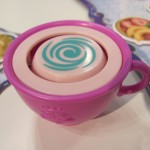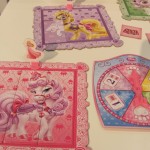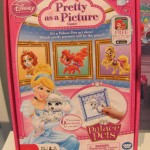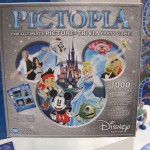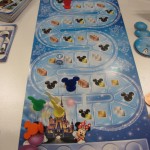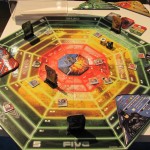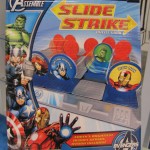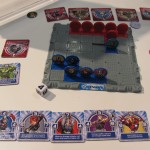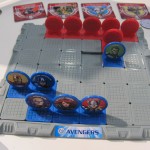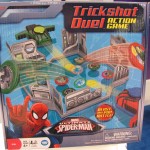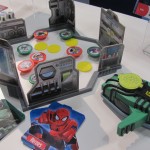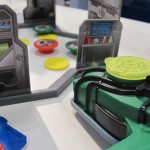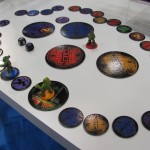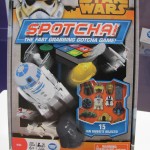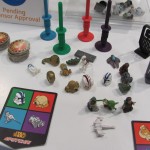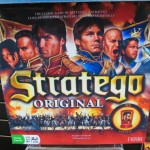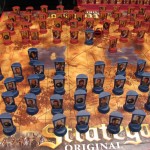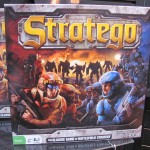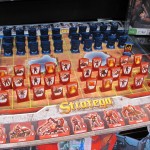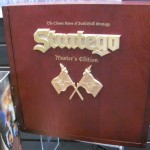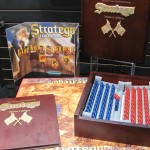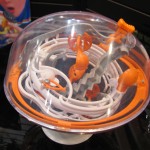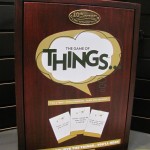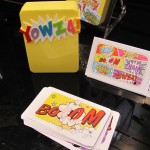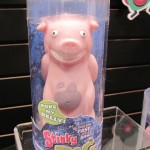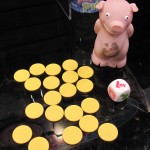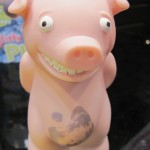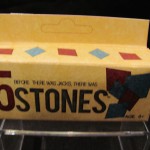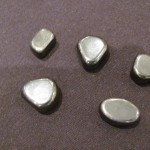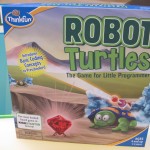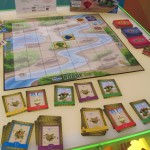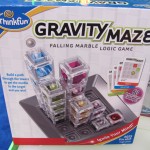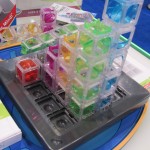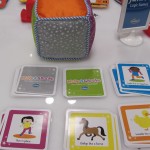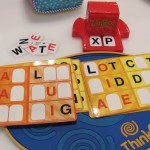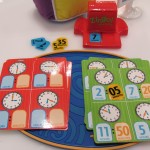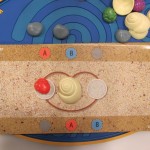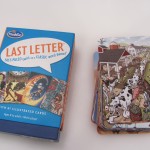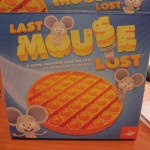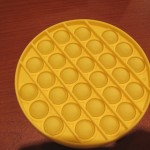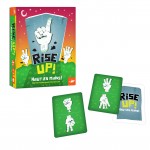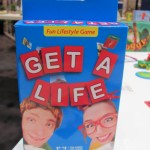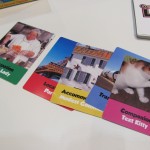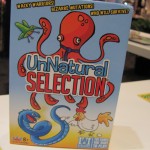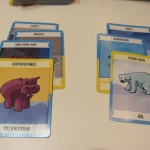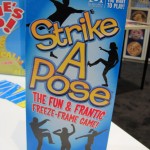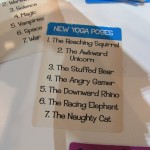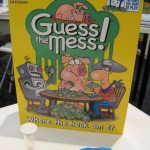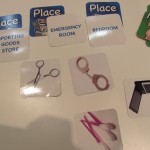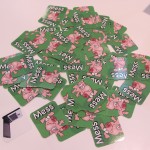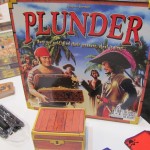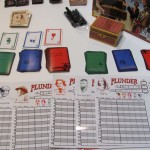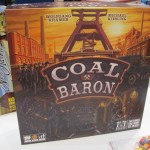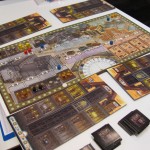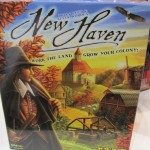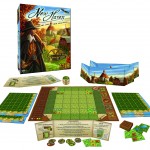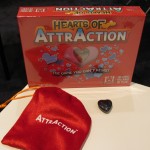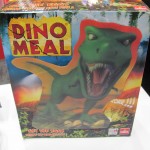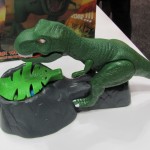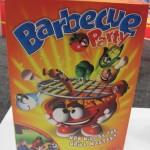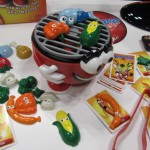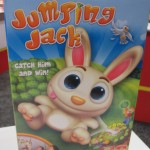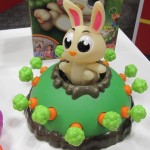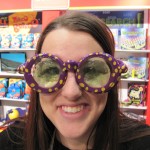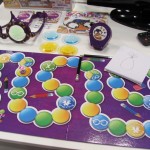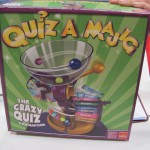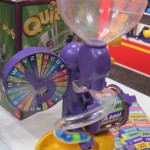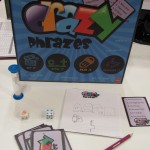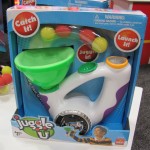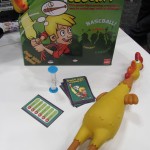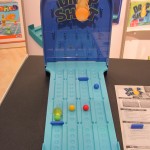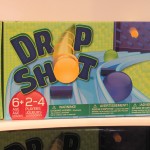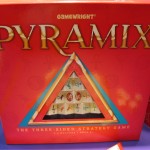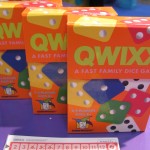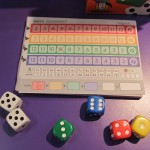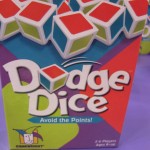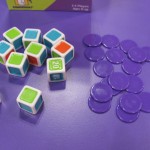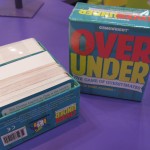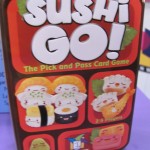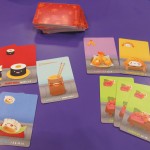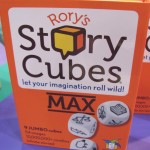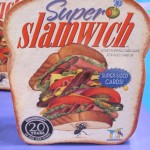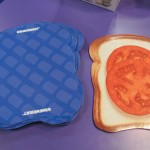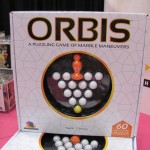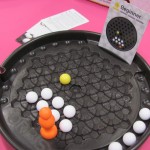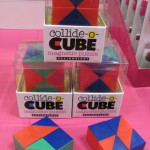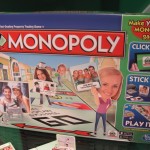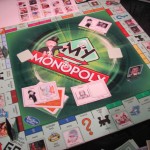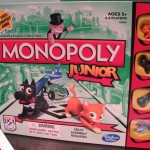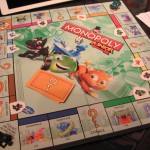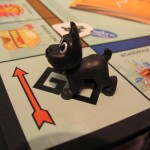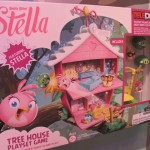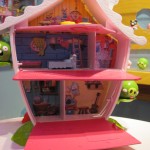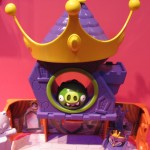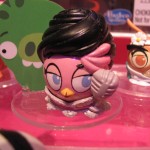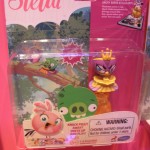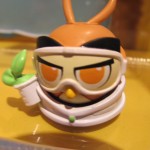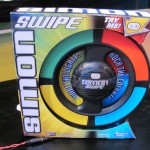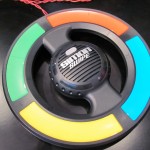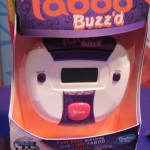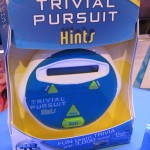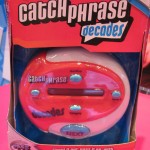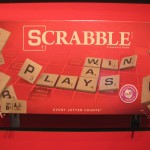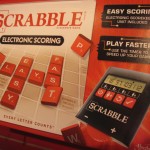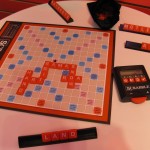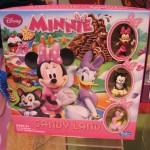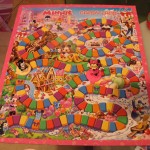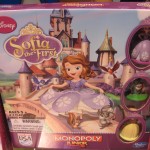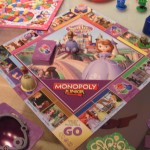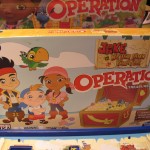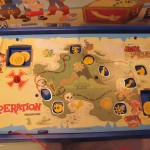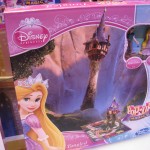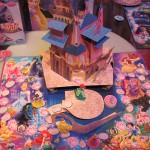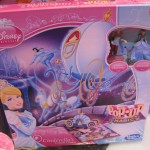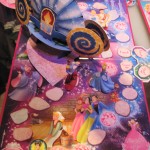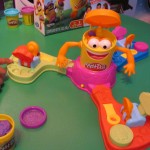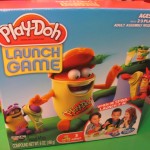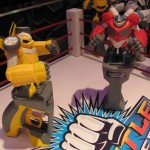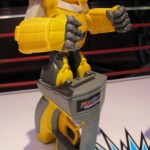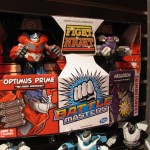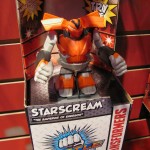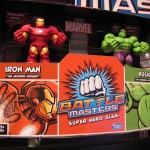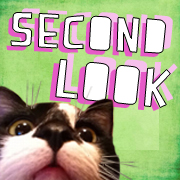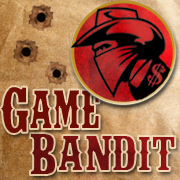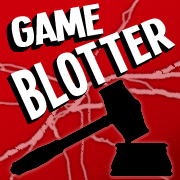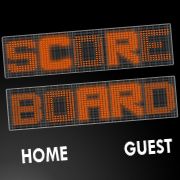 With licenses for Disney, Dr. Suess, Marvel, DC, TMNT, and Star Wars, Wonder Forge had on display 13 new games for 2014.
With licenses for Disney, Dr. Suess, Marvel, DC, TMNT, and Star Wars, Wonder Forge had on display 13 new games for 2014.
Dr. Suess Charades ($14, July) takes the well-known game and makes it manageable for 3 year-olds. On one side of each display card are three choices for the one player to act out, and on the other side are six choices from which the other players can guess.
Meant to be played around the house, the Disney Sky Race Action Game ($24) mimics the air race of Disney’s Planes. Display signs representing waypoints in various countries are placed in different rooms. Then the players toss foam airplanes around the established circuit. During the course of the race, flight control cards set special conditions. For example, a wind card requires players to toss their planes with opposite hand. A turbulence card means the players have to toss their planes upside-down.
Jake and the Neverland Pirates Shipwreck Beach Treasure Hunt Game ($24, April) combines matching and action elements and includes components that will probably see just as much use as role-play toys. Looking through the included spyglass, children decode secret clues then run to grab matching treasures using a foam sword.
Another matching game with lots of role-play opportunities is the Doc McStuffins All Better Game ($24, April). It comes with a medical kit bag, spinner, cardboard medical instruments, and slap bracelet bandages.
Included in the Sofia the First Magical Tea Time Game ($25) are tea cup devices, which a player blows on (as if to cool the tea), spinning a piece that determines the color of treat that player is supposed to collect.
In the Disney Princess Palace Pets Pretty as a Picture Game ($13, fall), players try to complete basic puzzles of the princesses’ pets. Certain space on the spinner, though, allow them to switch puzzles with other players.
Pictopia ($24, fall) is a Disney roll-and-move trivia game that covers the whole range of Disney properties, including classic cartoons, modern animation, and even teen pop music. The game also incorporates a wagering element. Players can bet on the answers in order to move their tokens forward.
The Justice League Axis of Villains Strategy Game ($24, May) challenges players to defeat a range of villains before they blow up space mission control. This one is very card and dice driven. A six-sided die determines what type of card a player gets, while an eight-sided die is used for movement.
Marvel Avengers Slide Strike Battle Game ($13, fall) combines a Stratego-like game of hidden pieces with a sliding-block puzzle. Each piece, Marvel superheroes on one side and villains on the other, have different strength ratings for their front, left, and right edges. A die roll indicates how many slides a player may make to move pieces around the board. When a hero and villain come in contact, the winner of the battle is based on the strengths of those characters on the edges that touch. To show that the losing character is out of the game, its disc is removed from the sliding block.
In the Marvel Ultimate Spider-Man Trickshot Duel Action Game ($23, fall) players are supposed to take turns using these doohickeys to shoot plastic discs and try to knock top-like pieces from the opponents team out of a building-like pen. Supposed to take turns, I said.
The Teenage Mutant Ninja Turtles Foot Clan Street Fight Game ($23, spring) has neat painted mini figures for each of the turtles and a board that varies with each game (the spaces are separate cardboard discs). In terms of play, though, it combines roll-and-move and matching.
Star Wars Spotcha! ($20, fall) is a grabbing game with small plastic pieces derived from the Star Wars universe: a speeder, C3PO’s head, Jabba the Hutt, and others. Someone drops all the pieces on the table and then the players rush to grab the ones that are lying in positions matching the players’ cards.
The Star Wars Rebel Missions Adventure Game is a cooperative, real-time, code-breaking game with an electronic device that acts as a timer and plays a soundtrack. The goal is to match the code and enter it on the device before time runs out. To collect pieces of the code, players visit Imperial installations on sabotage missions, using dice to collect the tools that will give them elements of the code.
- Comments Off on Toy Fair 2014—Wonder Forge
 Having taken over as of January the license for Stratego in North America, Patch Products had on display at Toy Fair four games tied to the classic title. Two, Stratego Original ($30, available May) and Stratego Sci-Fi ($20, available March), look and play the same as versions last published by Spin Master (I was told the artwork belongs to Royal Jumbo). One, Stratego Master’s Edition ($50, due in August), is just a deluxe version of Original. But one, Stratego Battle Cards ($10, available July), is a new game. Players lay out five cards as their front lines—there are cards for every traditional unit type—and then attack head-to-head.
Having taken over as of January the license for Stratego in North America, Patch Products had on display at Toy Fair four games tied to the classic title. Two, Stratego Original ($30, available May) and Stratego Sci-Fi ($20, available March), look and play the same as versions last published by Spin Master (I was told the artwork belongs to Royal Jumbo). One, Stratego Master’s Edition ($50, due in August), is just a deluxe version of Original. But one, Stratego Battle Cards ($10, available July), is a new game. Players lay out five cards as their front lines—there are cards for every traditional unit type—and then attack head-to-head.
Patch handles distribution of Perplexus (to specialty stores) and so was also showing Perplexus Warp, which introduces two new features to the 3D maze series. Number one, its shape is something the company is calling a “spherical octahedron”—still roughly round but now with eight somewhat flattened sides—designed to be easier to hold and less likely to roll off the table. Number two, there’s an external slider for manipulating the ball inside. This piece is given the name “warp drive”.
For 2014, Patch is also planning a The Game of Things 10th Anniversary Limited Edition, which at $40 will include a full new set of cards.
In Yowza ($8), players take turns flipping cards and chanting “Zap”, “Zoom”, “Boom”, “Bam”, “Wham”, and “Yowza”. Should the card a player flipped match the word that player chanted, then the whole discard stack becomes theirs. But of course the goal is to get rid of cards, not collect them.
And saving the best for last… Stinky Pig ($10, June) is a Hot Potato game. A die-roll tells players which way to pass the pig. They know time is up when the pig farts.
- Comments Off on Toy Fair 2014—Patch Products
 For its newest product, Griddly Games is going old-school, very old. In April, the company plans to release 5 Stones, a version of Knucklebones (also known as Fivestones or Jackstones and similar to Jacks, Kugelach, and Gonggi) with five hematite stones and a bag for $9.
For its newest product, Griddly Games is going old-school, very old. In April, the company plans to release 5 Stones, a version of Knucklebones (also known as Fivestones or Jackstones and similar to Jacks, Kugelach, and Gonggi) with five hematite stones and a bag for $9.
- Comments Off on Toy Fair 2014—Griddly Games
 Drawing the most attention at ThinkFun’s booth was Robot Turtles ($25, available June), a game originally launched on Kickstarter and designed to teach kids the principles of computer programing. Really more of a cooperative activity, Robot Turtles challenges kids to put together a sequence of program cards that will navigate the turtles around various obstacles. The challenges are presented at different levels of difficulty. As the kids succeed, not only do the challenges become more difficult, but the programing tools available to them become more sophisticated as well. For example, eventually program cards can be used to represent distinct subroutines.
Drawing the most attention at ThinkFun’s booth was Robot Turtles ($25, available June), a game originally launched on Kickstarter and designed to teach kids the principles of computer programing. Really more of a cooperative activity, Robot Turtles challenges kids to put together a sequence of program cards that will navigate the turtles around various obstacles. The challenges are presented at different levels of difficulty. As the kids succeed, not only do the challenges become more difficult, but the programing tools available to them become more sophisticated as well. For example, eventually program cards can be used to represent distinct subroutines.
Following on ThinkFun’s highly successful Laser Maze, the company is releasing this year Gravity Maze ($30, available June). Though less high-tech, Gravity Maze is a challenge puzzle that asks players to think in three dimensions. It’s like a marble run toy with a set goal.
For toddlers ThinkFun was showing Move & Groove ($20), an activity game with a large plush die and 48 move cards. Play is just about finding inspiration to move and dance. The color on the rolled die indicates from which stack the player draws a card.
Expanding the Zingo line are Zingo Word Builder ($20) and Zingo Time-Telling ($20). In the former, the sliding Zingo device dispenses letter tiles that are used to complete words. In the latter, the device dispenses hour and minute tiles to match against pictures of analog clocks.
The Shell Game ($20, available June) is a challenge puzzle with a memory component. Colored crab pieces are put under uniform shells and must be rearranged to match a new pattern using limited moves. The difficulty for the person trying to figure it out is remembering halfway through which shell holds which color crab.
Last Letter ($13) is based on that common word-association game where the last letter of the current word determines the first letter of the next word, except in this version all the words must be drawn from the artwork on one of the game’s many beautifully illustrated cards.
- Comments Off on Toy Fair 2014—Think Fun
 The latest from Fox Mind pack a lot of play in to simple games.
The latest from Fox Mind pack a lot of play in to simple games.
Last Mouse Lost ($9) is a two-player abstract strategy game with two rules. Number one, on a player’s turn, that player may punch any number of buttons in a single row. Number two, the last player to punch a button is the loser. (Students of game design will recognize this as a traditional Nim game.) The game is played on a one-piece rubber thingamajig that means you can’t lose any pieces (unless you lose the whole thing) and setting up for a new game is just flipping it over.
Rise Up ($15, available May) is a fast-play party game. Ten cards are laid out on the table. Every card pictures two hands with some combination of raised fingers. Each round, the players simultaneously raise one hand with any number of fingers up (0 to 5). Then with their other hands they race to grab cards that show the same number of fingers as any pair of players. Missing cards are replaced and a new round begins.
- Comments Off on Toy Fair 2014—Fox Mind
 Last year R&R Games debuted for the American market Hanabi, which went on to win the Spiel des Jahres award. Will any of these repeat the feat?
Last year R&R Games debuted for the American market Hanabi, which went on to win the Spiel des Jahres award. Will any of these repeat the feat?
Get a Life ($12, available April) is a party game in which players assemble companion, accommodation, occupation, transportation, and location cards for either the best lifestyle or the worst. The thing is only a portion of a player’s cards are laid on the table, and also action cards allow players to steal or trade cards with each other. Thus, it can be a surprise when a player that appeared to be aiming for worst lifestyle ends up capturing best.
The cards that comprise UnNatural Selection ($11) have both contestant and attribute aspects. The contestant is a type of creature (e.g., hippopotamus and minotaur) and the attribute a wide range of adjectives (e.g., gassy, wearing a clown costume, and academic). Each round, players submit creatures of theirs to compete in a new contest (such as “winner of a potato sack race” or “fastest sausage stuffer”). Then they use their remaining cards to attach attributes to their and their opponents’ creatures. When all cards are played, the player who’s turn it is to judge that round, must choose one creature as the victor.
Strike a Pose ($20, available April) is a Charades-like action party game with a fashion theme. Players are supposed to pose in ways that represent clues within a category. For example, the Yoga Poses category includes “The Awkward Unicorn” and “The Angry Gamer”. The Trades category includes “Cook” and “Shepherd”.
With Guess the Mess ($20, available April) players make a messy pile of item cards, then have 30 seconds to grab as many items as they can that fit a location card. But that’s not the end. When the timer runs out, players pass their collected cards to each other and try to guess which of the locations was the intended fit. For example, do worms, chocolate, bullets, and scissors go in a bedroom or desk?
Plunder ($25) is a detailed deduction game with a pirate’s hidden-treasure theme. The goal in Plunder is to figure out on which island, at which marker, and protected with what trap is each other pirate’s treasure. As players draw cards, ask questions, and narrow the possibilities, they take notes with dry-erase markers. Cards marked with guesses are placed in a treasure chest.
Coal Baron ($45) is a worker-placement game about mining set in the late 1800s in Essen, Germany. For victory points, players need to fulfill contracts for particular types of coal. To get at that coal, though, they’ll first need to expand their mine tunnels and purchase coal carts. But the longer they delay at sending workers to mine, the more workers it will take to extract the needed coal.
Combining tile-placement and resource-management, New Haven ($40, available April) has players building villages in a New World colony. Stone, sheep, wheat, and timber resources are collected through the placement of tiles, and then used to attract tradesmen, build amenities, and entice more colonists.
Hearts of AttrAction ($20) is mostly alternative packaging to AttrAction. The rules are the same. The main difference is that the magnetic pieces are heart-shaped, which R&R reports make them more active.
- Comments Off on Toy Fair 2014—R&R Games
 Visiting Goliath Games I expected to see some goofy stuff—I mean, this is the company that sold 6 million games about a pooping dog—and I was not disappointed!
Visiting Goliath Games I expected to see some goofy stuff—I mean, this is the company that sold 6 million games about a pooping dog—and I was not disappointed!
Dino Meal ($20) has players trying to steal eggs from the nest of a Tyrannosaurus Rex. They roll a die, reach under the leaf to grab an egg of the matching color, and hope that the T-rex doesn’t pounce. Batteries are not required but sound-effects will be added if you have them. Also, the box features a lenticular T-rex image.
Barbeque Party ($24), formerly an Asmodee game, is similar. Plastic food pieces are placed on a BBQ rack. Players then take turns removing food while trying not to trigger the rack springing in to the air.
In Jumping Jack ($25), players spin for the number of carrots to pull. One will trigger the bunny rabbit to jump, and when it does, the player who’s turn it is must try to catch it.
Googly Eyes ($24) is a Pictionary-like game. However, with this one comes a pair of glasses and a variety of vision-altering lenses. Spaces on the board indicate which set of lenses the person drawing the picture must wear.
Quiz A Majig ($20, available fall) is a trivia game built around a whacky-looking gizmo. Pull the lever and the gizmo spins two dials, pairing a category and first letter. The device also accepts marbles in a score-keeping function. When a player answers correctly, that player’s marble is directed to the visible score tube. The marble of a player that answers incorrectly is hidden.
Crazy Phrases ($20, available fall) is a party game in which players act, spell, draw, and describe idioms.
Catch It! ($24, available spring) is a straight-up action game—maybe more of a juggling toy. Battery-operated, the thing shoots foam balls in to the air for players to try to catch in it’s green funnel.
And finally, there is What the Cluck? ($20, available fall), THE most ridiculous, made-me-lough-out-loud game of Toy Fair! This game is charades with a rubber chicken. That’s right, Charades with a rubber chicken. In other words, players must find some way to incorporate the rubber chicken in to their acts. Now how can that not be funny?
- Comments Off on Toy Fair 2014—Goliath Games
 The show afforded me my first opportunity to play with Squashed—a short demo, mind you, but the quality of the product looked just as good as the game design is smart. Not only is the game 3D but play, in a sense, takes on an additional dimension as well. As players move their pawns up and around the sides of the cube, they may also at times flip that 3D game board to squash (eliminate) the pawns of their opponents. The person with the last pawn remaining in play is the winner.
The show afforded me my first opportunity to play with Squashed—a short demo, mind you, but the quality of the product looked just as good as the game design is smart. Not only is the game 3D but play, in a sense, takes on an additional dimension as well. As players move their pawns up and around the sides of the cube, they may also at times flip that 3D game board to squash (eliminate) the pawns of their opponents. The person with the last pawn remaining in play is the winner.
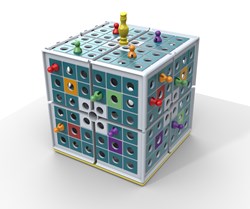
Another new game being demoed by Plasmart was Drop Shot. This one pairs up a simple race-to-the-top game with a Pachinko-like device that may randomly knock a player’s marble back down the track. However, the die that’s rolled for movement also has one face with a bar. When that bar is rolled, a player may place one of three gates anywhere in the race track, either in front of an opponent to block their way, or behind himself to limit how far back he may fall.
- Comments Off on Toy Fair 2014—Plasmart
 First up on my tour of Gamewright’s booth was Pryramix ($24), a game played in three dimensions. The board—if you care to call it that—is formed by stacking cubes in the shape of a pyramid. On his turn, a player may pull any cube exposed on at least two sides. Obviously, if the cube taken is not from the top, the one’s above it will slide down. An ankh cube is worth one point, a crane two points, and an eye three points. However, when only one cube remains in each stack, the game is over and the player with the most ankhs of each color scores a bonus equal to all the cubes that remain on the board with the matching color.
First up on my tour of Gamewright’s booth was Pryramix ($24), a game played in three dimensions. The board—if you care to call it that—is formed by stacking cubes in the shape of a pyramid. On his turn, a player may pull any cube exposed on at least two sides. Obviously, if the cube taken is not from the top, the one’s above it will slide down. An ankh cube is worth one point, a crane two points, and an eye three points. However, when only one cube remains in each stack, the game is over and the player with the most ankhs of each color scores a bonus equal to all the cubes that remain on the board with the matching color.
Next up was Qwixx ($11), a European dice game that Gamewright is bringing to the U.S. market. Qwixx is a fast-play game, where the players roll dice of various colors and mark off matches on a score sheet. The more spaces marked off, the more points a player scores. The trick is that once a player has marked off a space, he can’t go back to any space further left.
After Qwixx was another push-your-luck dice game, but one where the goal is to be the player with the fewest points. Dodge Dice ($11) features dice with colored faces; a penalty die, which indicates the number of points scored for matching colors; and an action die, which includes a face that forces the player to stop rolling and take points, a face that converts points to negative, and a face that allows the player to pass the points to someone else. Also, all players start the game with three skip chips, which allow them to bypass taking points for a turn.
Over Under ($10) is part of Gamewright’s Port-a-Party line. It’s a number trivia game where the reader of the question guesses whether everyone’s answers are either more than or less than the correct number.
Sushi Go! ($12), another title being republished by Gamewright, has players passing cards around the table, while keeping those they hope will give them the most maki or a full set of sashimi. In other words, it’s a game of card drafting.
After these new games, I got a look at two extra-large reprints being planned by Gamewright, Rory’s Story Cubes Max ($20) and Super Slamwich ($16).
And finally, from the company’s Brainwright line, I looked at two challenge puzzles, Orbis ($17) and Collide-o-Cube ($20). The former sets up a board with several white marbles, one yellow marble, and an orange pawn. The goal is to push the yellow marble in to the center of the board using the orange pawn. The pawn, however, can only move when and in a direction that it is pushing a white marble.
Collide-o-Cube is one of those three-dimensional puzzles that challenges one to match certain shapes and patterns. What makes this one particularly difficult, though, is that the pieces of this puzzle are magnetic, and therefore attract and repel each other in ways that aren’t apparent until placed close together.
- Comments Off on Toy Fair 2014—Gamewright
Toy Fair 2014—Hasbro Games
27 Feb
Posted by David Miller as Card Games, Electronic Games, Modern Board Games
 For Hasbro’s 2014 product lineup, let’s start with the company’s most famous brand… Later this year Hasbro launches My Monopoly, a version of the game in which property spaces, tokens, and some of the cards can be personalized with the My Monopoly app or website. Images can either be uploaded directly or drawn off of popular web services like Facebook and Instagram—the latter option making it particularly easy to personalize the game as a gift. At $20 retail, My Monopoly comes with enough labels to sticker over the default board four times.
For Hasbro’s 2014 product lineup, let’s start with the company’s most famous brand… Later this year Hasbro launches My Monopoly, a version of the game in which property spaces, tokens, and some of the cards can be personalized with the My Monopoly app or website. Images can either be uploaded directly or drawn off of popular web services like Facebook and Instagram—the latter option making it particularly easy to personalize the game as a gift. At $20 retail, My Monopoly comes with enough labels to sticker over the default board four times.
A simplified Monopoly Junior game ($15, available spring) for children as young as 5, limits money to just $1 bills; switches out the Atlantic City properties for an ice cream parlor, zoo, and swimming pool; and ends when the first player goes bankrupt.
Monopoly Angry Birds ($20, available fall) incorporates characters from Angry Birds, Angry Birds Space, and Angry Birds Go, as well as an action component. Players launch tokens at targets in the center of the board in order to score money and property bonuses.
More Angry Birds games also grace the TelePods line this year, in fact, a whole series in the fall for Rovio’s Angry Birds Stella. The Tree House Playset Game ($35) and Piggy Palace Playset Game ($25) introduce a new action element—the pigs must be knocked off their perches for the tree house or palace door to open. The Angry Birds Stella Birds Rock Together Collection ($20) requires players to knock pigs off of instrument stands so Stella and friends can form a band. And Angry Birds Stella Multipacks ($10 for two birds, one piggy, and accessories) and the Angry Birds Stella Friends Assortment ($6 for one bird and one piggy) allow people to build a collection of 20 Angry Birds Stella characters. All use the Telepods system for scanning figures with a mobile device and “teleporting” them in to the digital game.
Borrowing from mobile games, Simon Swipe ($20, available fall) is a slight update to the classic pattern-matching challenge. Now in addition to pressing a color, sometimes the player will have to swipe a finger along one of the pads.
Three of Hasbro’s party games get electronic treatments this year. Taboo Buzz’d, Trivial Pursuit Hints, and Catch Phrase Decades ($20 each, available late summer) replace the boards, cards, and score-sheets of the original games with battery-powered devices. For the most part, game-play is the same. However, Trivial Pursuit Hints will provide players up to three hints per question. For each hint taken, though, fewer points are scored. Catch Phrase Decades allows players to choose phrases from the 70s, 80s, 90s, or today.
In 2014, Hasbro is updating basic Scrabble’s graphic design and launching Scrabble Electronic Scoring ($20, available fall), which comes with a doohickey for recording scores and setting time limits on player turns.
Various Disney-licensed board games will see light in 2014. These include (available in the fall) Minnie Mouse’s Sweet Treats Candy Land ($15), Jake and the Never Land Pirates Operation Treasure Hunt ($20), and Sofia the First Monopoly Junior ($15).
Disney properties will also feature in a series of pop-up, three-dimensional board games this spring. All are basic spin-and-move games for ages 3+. The centerpiece of the series (literally) is the Disney Princess Castle Pop-Up Magic Game, which comes with plastic figurines of Ariel, Belle, Rapunzel, and Snow White for $20. Other entries in the series (all $13) are the Disney Princess Frozen Pop-Up Magic Game, the Disney Princess Cinderella’s Coach Pop-Up Magic Game, and the Disney Princess Tangled Pup-Up Magic Game. Playable separately, all four can also be combined in to one extended game by clipping the boards together.
Another new game for the young set (ages 4+) is the Play-Doh Launch Game ($20, available fall). It’s played by forming Play-doh in to different little shapes, then flicking those shapes in to the top of the canister rotating in the center. Pretty much like older kids do, but in to a neat container instead of at each other.
Finally, Hasbro is launching this year a game series that to me seems to have a little bit of a retro vibe, Battle Masters. Be calm, Warhammer fans, besides the name, this has nothing to do with the Milton Bradley title of the early 90s. Instead, it’s more like Rock Em Sock Em Robots, though without the requirement for a board or table. Plastic figures mount on trigger-grip or D-pad style controllers. Transformers Battle Masters will start selling in the spring, Marvel Battle Masters in the fall. Sets with two figures and two controllers will be priced at $25, sets with one figure and one controller at $15, and individual figures at $10. Yet the game isn’t entirely retro. Every product in the line includes a code for some sort of mobile game tie-in.
Trending
- Massdrop.com
- Oh the Irony—Illuminati Card Game Continues to Inspire Conspiracy Theorists
- Home
- Footprints, an Educational Ecology Game
- USPS Adds Board Game Flat Rate Box
- Baila, the Estonian Drinking Card Game
- Crystal Caste Wins Dice Patent Suit Against Hasbro
- Mirror Game, Red and Blue
- Are Board Games Dangerous?
- The Truth About Dominoes On Sunday in Alabama
Archives
Most Popular Articles
- Oh the Irony—Illuminati Card Game Continues to Inspire Conspiracy Theorists
- The 20 Most Valuable Vintage Board Games
- The Truth About Dominoes On Sunday in Alabama
- Sequence Game, and Variants
- USPS Adds Board Game Flat Rate Box
- Baila, the Estonian Drinking Card Game
- The 13 Most Popular Dice Games
- Are Board Games Dangerous?
- Guess Who? The Naked Version
- What Happened to the Jewel Royale Chess Set?
Recent Posts
- Toy Fair 2019—Breaking Games
- Talisman Kingdom Hearts Edition
- Toy Fair 2019—Winning Moves
- Toy Fair 2019—Games Workshop
- Toy Fair 2019—Star Wars Lightsaber Academy
- Toy Fair 2019—Stranger Things Games
- Toy Fair 2019—HABA
- Licensing Roundup
- Game Bandit
- 2018 A Difficult Year For Hasbro But Not For D&D Or MtG
Recent Comments
- on Toy Fair 2019—Winning Moves
- on Game Bandit
- on Second Look—Dungeons & Dragons Waterdeep Dragon Heist
- on Crowdfunding Highlights
- on Beyblade SlingShock
- on Game Bandit
- on Game Bandit
- on Watch This Game!, the Board Game Review Board Game
- on Second Look—Vampire: The Masquerade 5th Edition
- on Palladium Books Loses Robotech IP License, Cancels Five-Year-Overdue Robotech RPG Tactics Kickstarter

